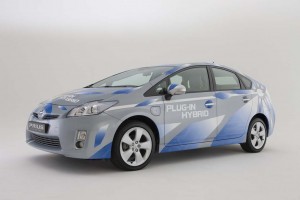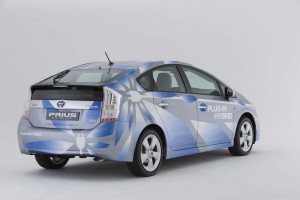
The 2011 Prius Plug-in Hybrid will launch during the first half of 2010 - but only for fleet markets. Retail sales won't begin for another year.
There’s an old adage, in the business world, about “first mover advantage.” Deliver a breakthrough product and, even if it falls short of what eventually comes to market, you’ve got an edge on the competition.
So, after initially shrugging off plug-in hybrid technology, Toyota announced today that it will have its first model to market by the first half of 2010. But the first batch of about 600 copies of the 2011 Toyota Prius Plug-in Hybrid will be delivered to business and government fleets. The automaker won’t start selling to consumers until sometime in 2012.
So, while the Japanese maker will get bragging rights, the real lead in the retail market will go to General Motors, which plans to deliver its own plug-in model, the Chevrolet Volt, to retail showrooms by late 2010.
The two makers are taking a very different approach to the underlying technology, as well. The 2011 Toyota Prius Plug-in starts out with the same basic hardware as the conventional Prius hybrid. But it gets a larger 5.2 kWh battery and one using newer lithium-ion chemistry, rather than the nickel-metal hydride batteries used in the standard Prius.

The 2011 Toyota Prius Plug-in will get about 14 miles on a fully-charged battery, at speeds up to 60 mph.
This will allow it to travel up to 23.4 kilometers, or just over 14 miles, in pure electric vehicle mode, compared to a little more than a mile for today’s Prius. Top speed on battery power alone will be just 60 miles an hour, which means that in much of the U.S., motorists would have to drive below the speed limit to take advantage of the EV feature. But the automaker envisions the vehicle as primarily appealing to those in urban environments with short commutes in stop-and-go traffic.
At higher speeds, or when the battery runs down, the 2011 Toyota Prius Plug-in Hybrid will function as a conventional hybrid, meaning it will recapture energy lost during braking and coasting and use it to help accelerate the vehicle. Toyota claims that using the Japanese fuel economy standards, the new Plug-in will get 57 km per liter, or about 134 mpg, and that combining the gas and electric drivetrains will yield more than 800 miles on a combined fill-up and charge.
The 2011 Chevrolet Volt, by comparison, will have a top speed of around 100 mph, but more significantly, it will be able to run up to 40 miles solely on its lithium-ion battery pack. The automaker’s research shows that this would be enough to satisfy the driving needs of 70% of American motorists. Using a controversial new EPA measurement system for electrified vehicles, GM has estimated Volt will get about 230 mpg.
GM has taken a markedly different technological approach with Volt, which it prefers to call an “Extended-Range Electric Vehicle,” or E-REV. Where Prius’s wheels can be powered by either its gasoline engine or electric motors, Volt uses only electric drive. There is an onboard internal combustion engine, but it kicks in only when the batteries run down. And the 1.4-liter inline-four powerplant serves only as a generator, producing electricity that can either be used to run the motor or recharge the battery.
But for many buyers, the real selling point could be price.
Toyota isn’t saying what it will charge the first fleet customers – 230 in Japan, 150 in the U.S., and another 200 in Europe. At a preview, in Japan, Executive Vice President Takeshi Uchiyamada would only say that the retail version would be offered at a “reasonable price” when it reaches showrooms for the 2012 model-year.
“I can only say it will be a price that will have potential buyers seeing a plug-in as a viable option,” added Uchiyamada. The standard version of the 2010 Toyota Prius carries a list price ranging from $21,750 to $28,420.
GM officials also have declined to provide a hard price for the 2011 Chevrolet Volt, but industry sources have predicted it will come in somewhere around $40,000. But the vehicle – like the Prius Plug-in – would qualify for a $7,500 federal tax credit and possibly other tax credits and deductions on the state level, as well.
Nonetheless, industry analysts, such as Joe Phillippi, of AutoTrends Consulting, worry that the price tag could limit demand – unless, he suggests, fuel prices start moving back up to the $4 a gallon level again. At that level, a battery car could operate for as little as one-tenth the cost, per mile, of a comparable gasoline vehicle.
Another factor that analysts say could influence consumers is battery charging time. Toyota plans to make available a special fast charger that would allow the 2011 Prius plug-in to have a fully-charged battery in as little as 3 hours. The longer-range battery of the Volt would need an eight-hour charge, using a standard 110-volt outlet, but GM also plans to make a faster, 220-volt charger available.
One of the big challenges for all battery car manufacturers will be finding a way to charge a vehicle when a motorist is on the road – and for owners who don’t have access to a garage.
Toyota’s push into “electrification” marks a sharp reverse by the Japanese maker which, as recently as last January, indicated it did not think lithium technology was ready for the mass market. “It’s all about the battery,” said Bob Carter, head of the U.S. Toyota division, adding that the automaker now believes the chemistry can be made reliable enough for use on the road.
But Kurt Sanger, an analyst with Deutsche Bank, cautioned that Toyota is still taking a cautious approach. “Talks with the company at the (Prius Plug-in launch) gave us the impression that the batteries used for the model was specialized for PHEVs and could not be simply put on a Full EV without further property adjustments.”
When it comes to pure Battery-Electric Vehicles, or BEVs, Toyota’s cross-town rival Nissan hopes to get first-mover advantage among major automakers. It plans to put the 2011 Nissan Leaf on sale next year. That model will have no internal combustion engine for back-up but will initially deliver about 100 miles range per charge.
